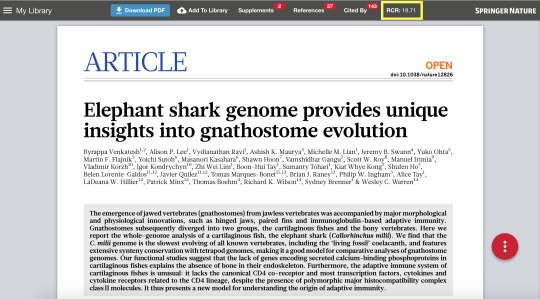Learning more about RCR (Relative Citation Ratio)
When you are looking at an article via ReadCube’s web reader, you will notice there is a new addition to the top bar called “RCR”.

The Relative Citation Ratio (RCR) is a new citation-based measure of article influence, developed by the Office for Portfolio Analysis (OPA) at the National Institutes of Health in the USA. It’s designed to address some of the shortcomings of more standard citation number and Journal Impact Factor (JIF) measures.
Some areas of research experience higher average levels of citation than others, leading to a citation count of ‘8’ being regarded as high in some fields, but low in others. Along the same lines, a new paper may represent a significant scientific breakthrough, but it will have a low citation count if published recently. RCR normalizes an article’s citation number to both time since publication and the field in which it was published, as using citation number alone (see “Times cited”) does not account for them. By taking these additional dimensions into consideration, RCR attempts to produce an improved indication of impact and reception.
RCR will now be appearing not just across the ReadCube app – but also in:
Symplectic, a provider of world-leading research information management software and services, plans to make RCR available to 37% of the members of the American Association of Universities and over 80 leading research centers around the globe, via its flagship product, Elements.
Figshare, an online digital repository to help academic institutions manage, disseminate and measure the public attention of all their research outputs whilst helping them meet key funder recommendations. Figshare provides world-leading tools to support an open culture of data sharing and collaboration.
ÜberResearch’s Dimensions platform with more than 200 funders and over $1 trillion in historical grant awards integrated has been updated with RCR in the corresponding publication data. This change will have particular improvement to Reviewer Identification tools, which will now include RCR scores in the over 3M disambiguated author profiles available in Dimensions.
For more information on these, and other RCR improvements, check out > RCR and OPA!